Sautéing on High Heat: A Guide
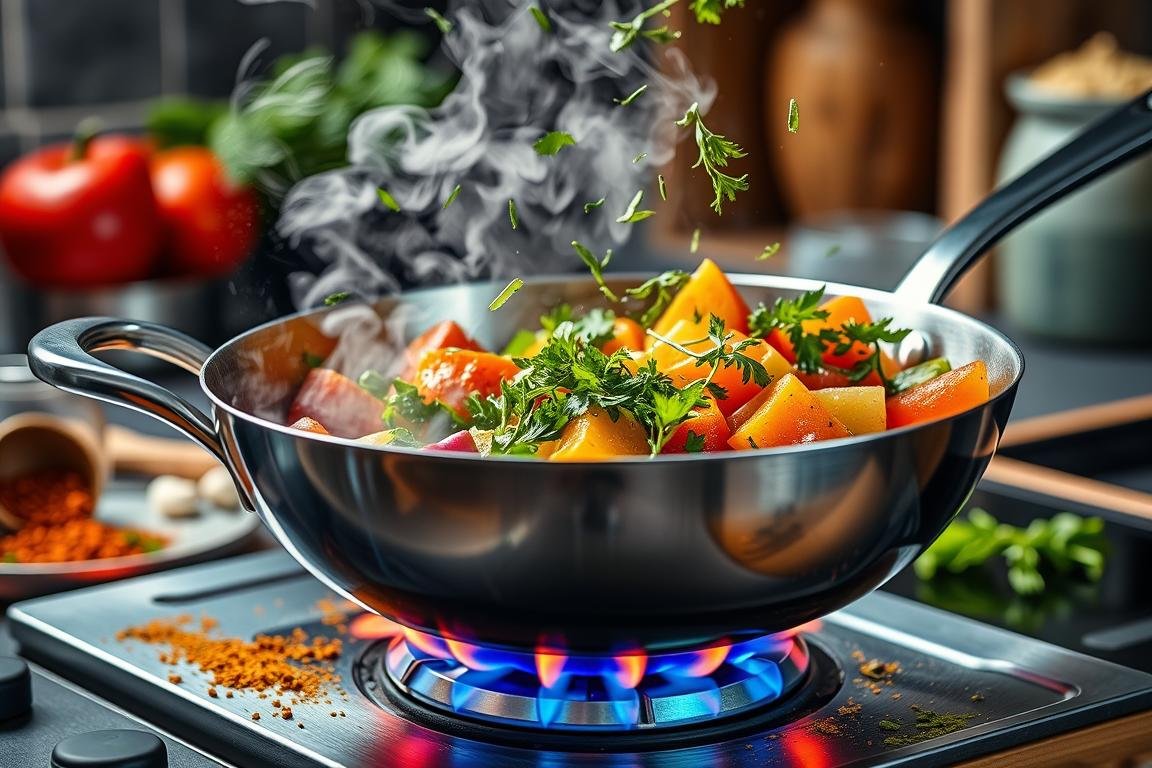
Ever wonder why home-cooked meals don’t taste like those in restaurants? The trick may be in high-heat cooking. This guide will show you professional stovetop cooking techniques. It’s your gateway to achieving restaurant-style sautéing at home.
Key Takeaways
- High-heat cooking mastery is key for a golden crust and tender insides.
- Stovetop techniques on high heat are quick and keep flavors deep.
- To sauté like restaurants, focus on choosing ingredients, controlling heat, and using the right tools.
- The right skillet and oil are vital for successful sautéing, impacting dish quality.
- Avoid overcrowding the pan to ensure good texture and flavor.
- Knowing your equipment boosts your sautéing skills.
- Choose ingredients and cookware designed for high heat for top-notch sautéing.
What is Sautéing on High Heat?
Sautéing on high heat is a way to blend flavors and control temperatures skillfully. It involves choosing the correct sauté pan and improving your sautéing skills. This approach is based on cooking with dry heat. It offers quick, tasty meals easily.
Definition and Basics
Sautéing on high heat means quickly cooking food that’s thinly cut or small in a hot pan with a bit of fat. High heat helps seal juices in and creates deep flavors by caramelization, usually in just a few minutes. A well-chosen sauté pan with even heat prevents burning and cooks food evenly.
Making sure food is dry before it goes in the pan is important because moisture can stop browning. The oil used needs a high smoke point to avoid burning. This helps in flavoring the food better.
Cooking Techniques Overview
To master sautéing on high heat, knowing how to use a sauté pan is key. Here are some tips to improve your sautéing technique:
- Pan Selection: Choose a pan that’s shallow and broad so food can spread out. This helps heat spread quickly and keeps food from being too crowded.
- Heat Conduction: A pan with a thick bottom can handle high heat without warping. It keeps the temperature even, so food cooks uniformly without burning.
- Motion: Stir or toss your food often to expose it evenly to the heat. This prevents it from sticking and promotes the Maillard reaction, which makes browned food taste good.
- Oils with High Smoke Points: Use oils like sunflower or safflower that can take high heat for effective sautéing.
Sautéing is more than a way to cook food. It’s an opportunity to unlock the full potential of ingredients. It keeps the nutrients in the food and brings out new textures and flavors. With the right tools and these tips, you can create amazing meals with great flavors and looks.
The Benefits of High Heat Sautéing
Diving into high heat sautéing opens up many cooking benefits. It enhances the taste and speed of cooking. By quickly transferring heat, it brings out complex flavors and keeps the nutrients in food. Learning about high heat sautéing will make you a better cook.
Enhanced Flavor Development
High heat sautéing is known for creating amazing tastes. It makes use of caramelization and the Maillard reaction. These processes turn simple foods into rich, flavorful dishes. For example, when food heats up, the Maillard reaction adds deep flavors to both meats and veggies.
Caramelization brings out a sweet taste and great color in foods like onions and carrots. This method can’t be achieved with low heat, making it special.
Faster Cooking Times
This cooking technique also speeds up meal prep. It suits those with busy lives who still want to enjoy good food quickly. High heat is perfect for searing steaks or making veggies tender and tasty. It ensures your dishes have the best texture and flavor, similar to what you get in restaurants.
These quick cooking tips are crucial today. They help get food from the kitchen to the table fast, without losing out on quality.
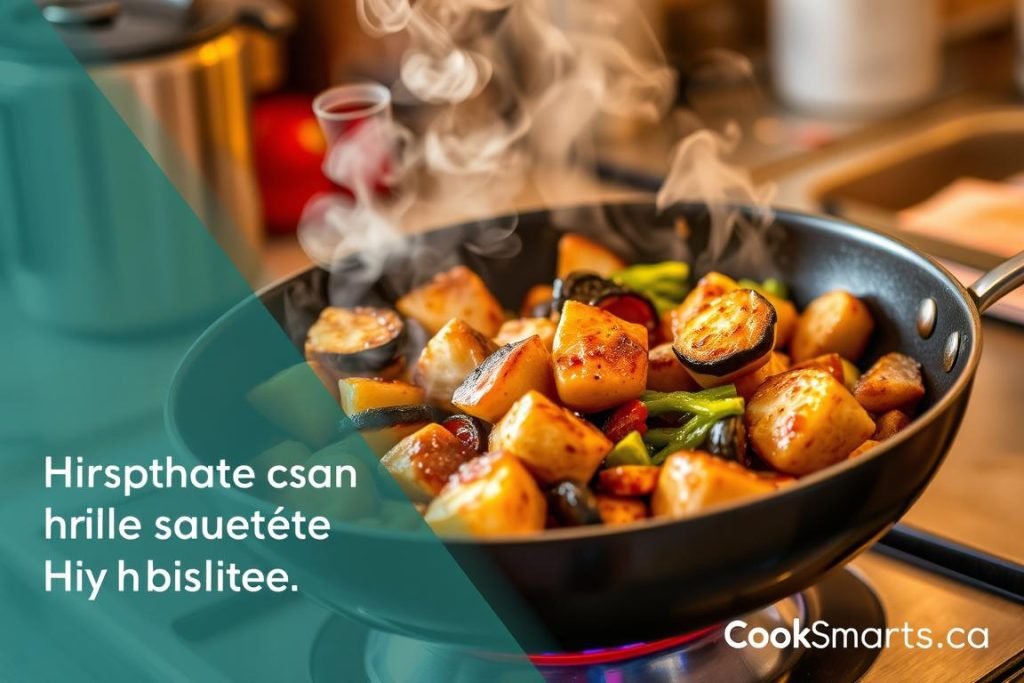
| Aspect | Benefit |
|---|---|
| Oil Selection | Choosing oils with high smoke points like olive oil helps keep temperatures right. This prevents the loss of good compounds. |
| Kitchen Tools | The right tools, like a heavy-bottomed sauté pan, spread heat evenly. This avoids burning and hot spots. |
| Ingredient Preparation | Preparing everything ahead of time saves time. It also makes sure all ingredients cook evenly. |
| Technique Mastery | Using techniques like flipping ensures food cooks well all around. Every bite will be just as delicious as the last. |
Using these methods in your cooking not only saves time. It also improves the taste in your dishes. This makes high heat sautéing an important skill for chefs.
Choosing the Right Ingredients for Sautéing
The art of restaurant-style sautéing is more than just heating food. It hinges on choosing suitable ingredients. These selections play a huge role in how the dish tastes. We will look into picking vegetables and proteins, which are vital for great dishes in stovetop cooking techniques.
Fresh Vegetables vs. Frozen
Fresh veggies can change the game in sautéing. They offer better texture and help with flavor development. While frozen veggies can be convenient, make sure they’re not wet. This keeps your dish from just steaming instead.
Selecting the Best Proteins
For a great searing methods, choosing the correct protein is key. Go for meats that are lean and tender for a nice, quick cook. Choices like chicken breast, thin beef or pork, and seafood are great. They brown well under high heat without getting dry inside.
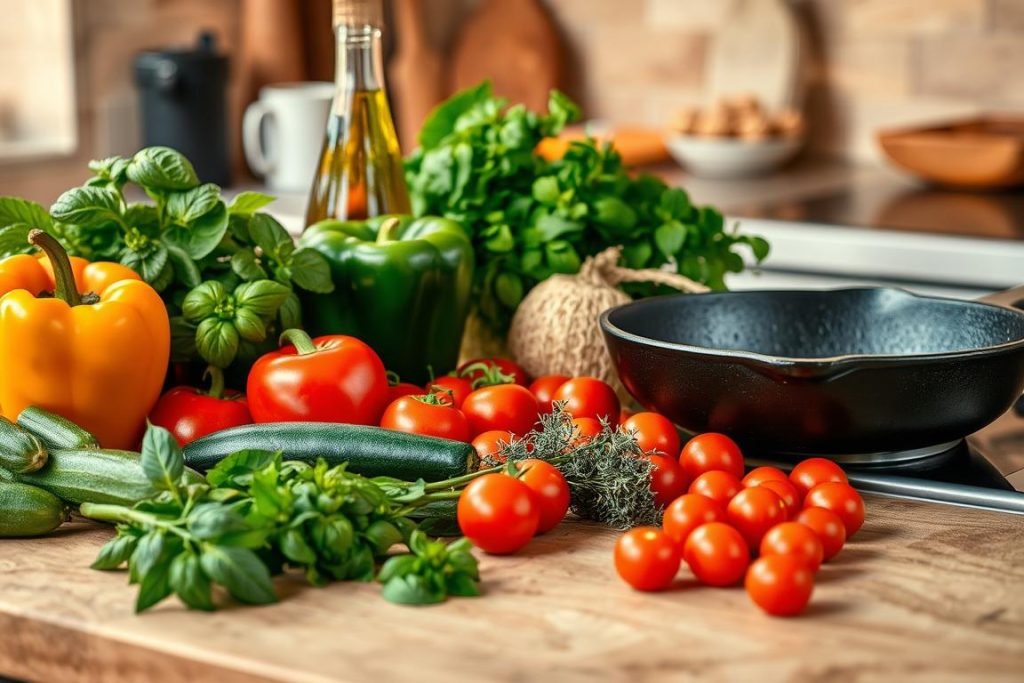
It doesn’t matter if it’s a quick meal or something fancy, knowing which veggies and proteins to combine can enhance your sautéing. Good flavor development and texture in restaurant-style sautéing mainly come from using the right ingredients.
Essential Cooking Tools and Equipment
The right tools are key for high-heat cooking. Choosing suitable equipment can improve your cooking and your dishes’ taste. Let’s explore essential skillets, pans, and why a good spatula matters.
Must-Have Skillets and Pans
Having the right sauté pan matters a lot in cooking. For beginners, nonstick skillets are great because food won’t stick. But, stainless steel skillets are better for those who want durability. They’re great for searing meats and veggies evenly.
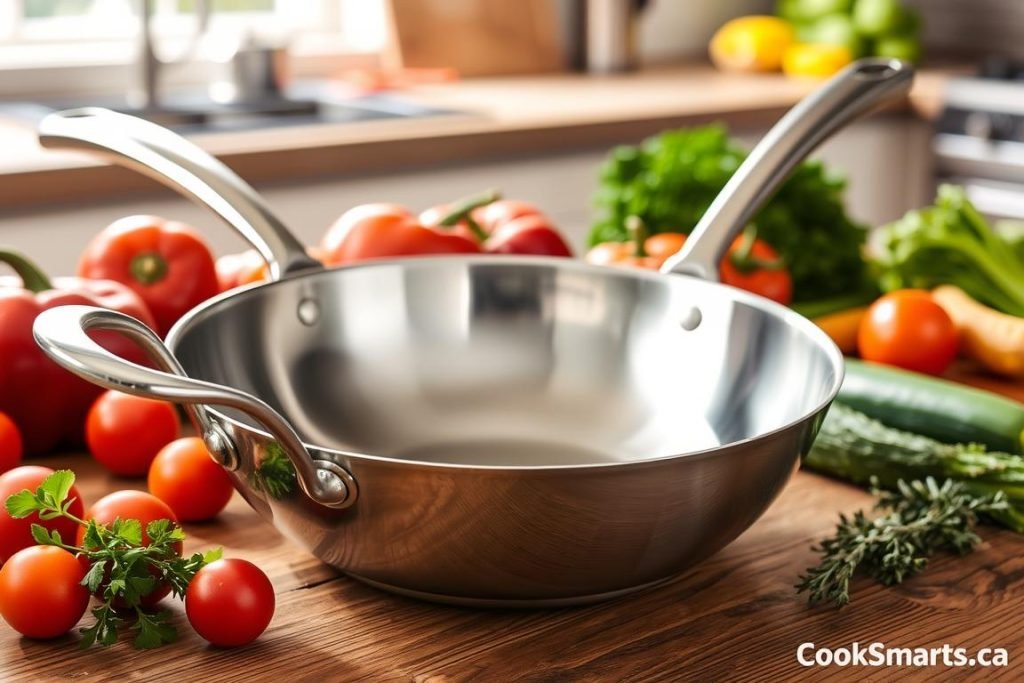
If you often cook at high temperatures, think about a cast iron skillet. It’s versatile, good for sautéing, frying, baking, and grilling. The Tramontina Professional Fusion 14-inch Fry Pan is a top choice. It’s known for excellent heat control and long-lasting use.
The Importance of a Good Spatula
Having a top-quality spatula is essential. It’s not just for flipping food. The right spatula helps you stir ingredients carefully, cooking them evenly. Silicone spatulas are best since they don’t melt or warp at high temperatures. They’re also soft on your cookware, keeping it in great shape.
Using the right tools, like a nonstick skillet for pancakes or a stainless steel pan for veggies, makes cooking easier. These tools help you do better in the kitchen and make your meals tastier.
Prepping Your Ingredients for High Heat
Before you start cooking, getting everything ready is key. Knowing how to chop your ingredients makes sure they all cook at the same pace. This makes the food taste better. Marinating your meat or other proteins is also crucial. It adds depth and makes every sautéing session fantastic.
Cutting Techniques for Even Cooking
To make sure everything cooks evenly, size matters. When you cut veggies and meats the right way, each bite is just right. Here’s a guide for prepping:
- Chop veggies into pieces that are all the same size for even cooking.
- Flatten chicken or fish to the same thickness for quick and even cooking.
- A sharp knife is your best friend for cutting everything evenly.
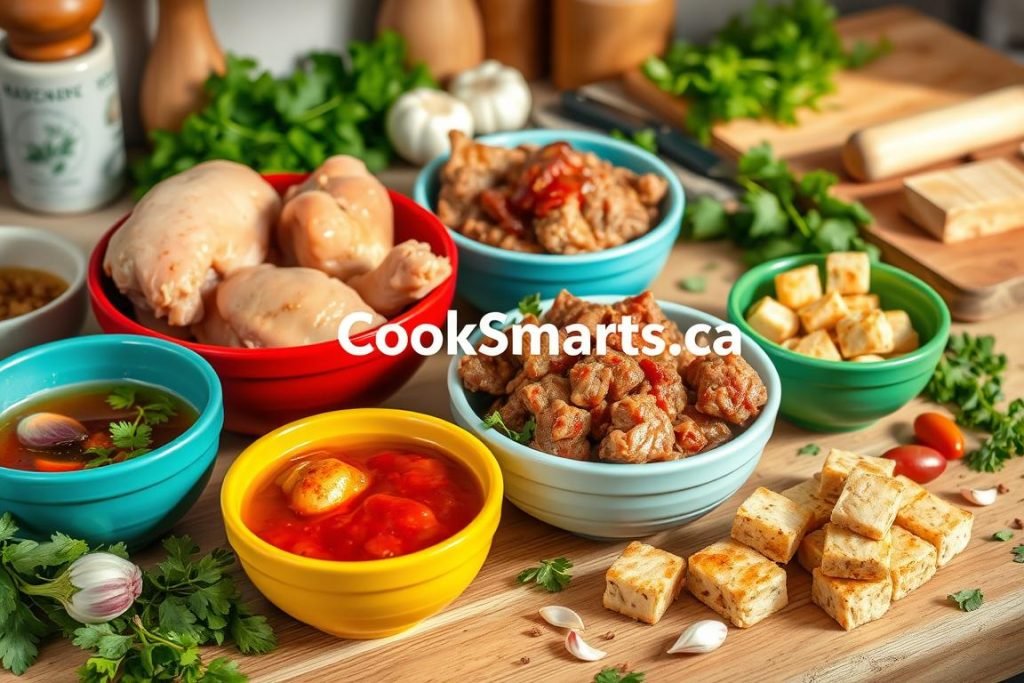
Marinating Proteins for Flavor
Marinating isn’t just for taste. It also helps with texture and speeds up cooking. For a good marinade, remember these tips:
- Add lemon juice or vinegar to soften protein fibers. This also helps with flavor and making the meat tender.
- Spices and herbs boost the dish’s taste and aroma.
- Let your proteins sit in the marinade for hours or even overnight. This ensures deep flavor and keeps it moist when cooked.
These tips for quick cooking boost both the taste and quality of your meals. With these cutting and marinating methods, you’re all set to tackle high heat sautéing.
Understanding Heat Control
Learning to cook with high heat can make your food taste better and save you time. You need to know how to adjust your stove and control the heat. This way, you’ll get amazing results when you sauté.
Stove Settings Explained
Your stove has burners with different strengths. It’s important to know what each burner can do. You’ll find some are for boiling or searing quickly.
This knowledge is key for fast cooking like boiling water or searing meat just right.
Managing Temperature Fluctuations
After you start cooking on high heat, keeping the right temperature is important. This prevents burning your food or not cooking it enough. If you have an electric stove, it might be harder to change the heat quickly.
Practicing with your stove will help you learn how it reacts. This makes managing the heat easier.
| Heat Level | Typical Uses | Stove Type Responsiveness |
|---|---|---|
| High/Power Boil | Boiling liquids, high-heat frying | Immediate (Gas), Slower (Electric) |
| Medium-High | Sautéing, browning meat | Responsive (Gas), Moderate (Electric) |
| Medium | Cooking vegetables, simmering sauces | Steady (Gas), Gradual (Electric) |
| Low/Simmer | Long-duration simmering, delicate sauces | Controlled (Gas), Steady (Electric) |
As you get better at cooking, using your stove right will help you face any recipe. Whether you’re searing steak or simmering a Bolognese, knowing your stove is key. Remember, cooking on high heat requires precision and patience. It’s all about using power in a controlled way.
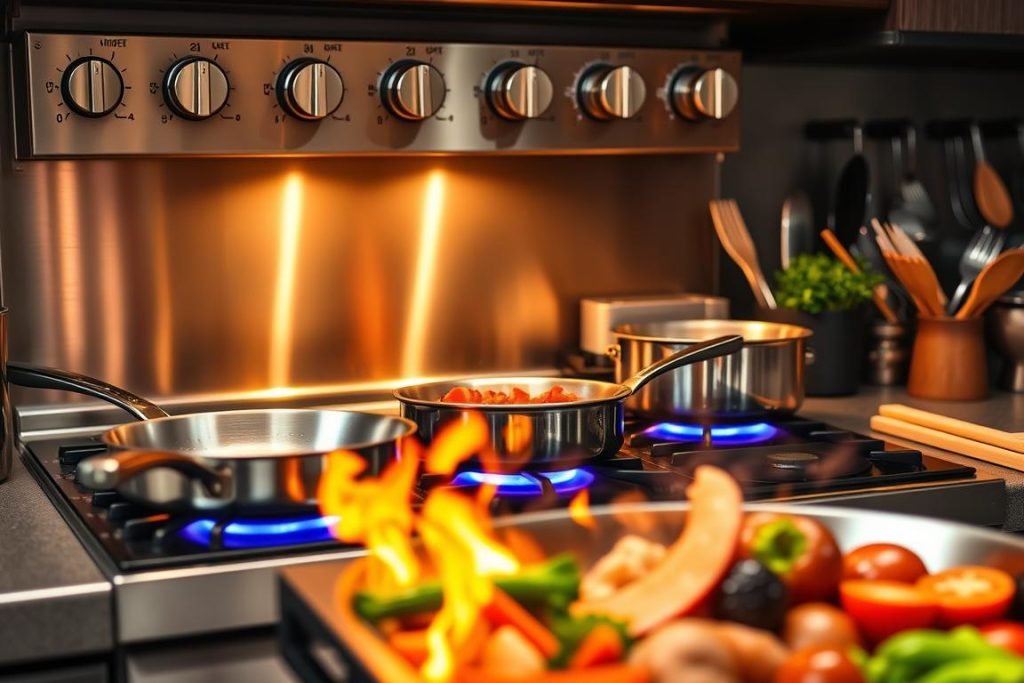
Oil Selection: What Works Best?
Learning how to sauté starts with choosing the right oil. It’s not just smoke point that matters, but also adding flavors and health benefits to your food. Here’s the key info you need.
Types of Oils and Their Smoke Points
For high-heat cooking, pick oils that can take the heat without burning. Avocado oil, with its high smoke point of about 520°F, is perfect for sautéing. Meanwhile, extra-virgin olive oil, which has a smoke point around 350°F, is better for cooler cooking methods.
The smoke point can change based on how the oil is made and where it comes from. So, choosing the right oil can make your food tastier and healthier.
Combining Oils for Flavor and Stability
Mixing oils can give you the best of both worlds: great flavor and high smoke point. For example, mixing grapeseed oil (smoke point about 420°F) with flavorful extra-virgin olive oil can keep the oil stable at high temperatures. This mix also boosts the nutritional value of your food.
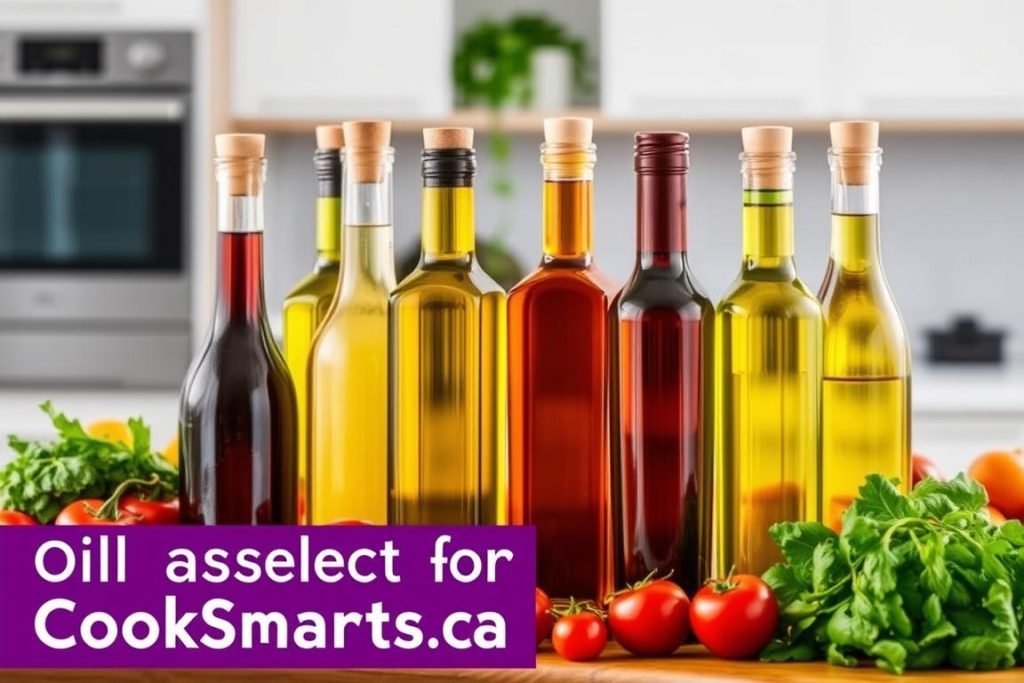
To better understand oil selection, look at this detailed table showing different oils and their characteristics:
| Type of Oil | Smoke Point | Suitable For | Flavor |
|---|---|---|---|
| Avocado Oil | 520°F | High-heat sautéing, grilling | Buttery, mild |
| Light Olive Oil | 465–470°F | Frying, sautéing | Mild with a light fruitiness |
| Extra Virgin Olive Oil | About 350°F | Low-heat cooking, sauces | Rich, fruity |
| Refined Coconut Oil | 400°F | Baking, frying | Neutral, sweet |
| Grapeseed Oil | 420°F | Sautéing, dressings, vinaigrettes | Light, clean |
Knowing all about oil selection helps you master your sautéing technique. The right oil does more than just add flavor. It makes your cooking healthier and your dishes tastier.
Perfecting Your Sautéing Technique
Mastering the art of sautéing can take your cooking from okay to amazing. It’s all about the right techniques and how you use heat and ingredients.
The Right Amount of Oil
Starting with the correct oil amount is key for taste and health. Usually, a tablespoon or two, depending on the pan size, does the trick. This makes sure the heat reaches all ingredients properly, which is vital for sautéing the right way.
How to Avoid Steaming Instead of Sautéing
It’s easy to steam food by mistake when you’re trying to sauté. Make sure the pan is hot before you add anything. It should be on medium-high heat, an important tip for cooking on the stove. Also, don’t put too much in the pan at once. If you do, your food will steam instead of browning.
Look for a strong sizzle when food goes into the pan. If the sizzle fades, your pan might be too crowded.
| Ingredient | Smoke Point | Cook Time | Oil Needed |
|---|---|---|---|
| Extra Virgin Olive Oil | Above 375ºF | N/A | 1-2 Tablespoons |
| Butter | 350ºF | N/A | 2 Tablespoons |
| Chicken Breast | N/A | Until Safe Temperature | 1 Tablespoon |
| Mushrooms | N/A | Few Minutes | 1 Tablespoon |

The key to great sautéing is managing high heat and understanding its effects. Doing it right doesn’t just cook the food. It also boosts flavor, texture, and appeal.
Common Mistakes to Avoid
Mastering the art of sautéing can make your dishes tastier and boost your cooking skills. But, cooks often make simple mistakes that hurt their cooking. By not overcrowding and cooking at the right temperature, you can improve your sautéing skills.
Overcrowding the Pan
One big mistake is putting too much in the pan at once. This usually happens when trying to cook faster. But, putting too much food in the pan can lower its temperature. This causes food to steam instead of sauté, making it soggy and bland. It’s better to cook in smaller amounts for even heating and browning.
If you’re cooking a lot, do it in batches. While it takes more time, it ensures every piece cooks right. This way, the food keeps its texture and taste. Remember, not cramming the pan is key to a good dish.
Cooking at Too Low a Temperature
Not keeping the pan hot enough is another common error. Sautéing needs high heat to cook quickly and seal in flavors. Some are scared to use high heat, fearing they’ll burn the food. But a hot pan is essential for a successful sauté.
If the pan and oil aren’t hot when food is added, the food releases moisture. This cools the pan and makes the food boil, not brown. Be sure your pan is hot around 212°F and your food sizzles when it hits the pan. Dry your ingredients and cut them evenly for the best browning and texture.
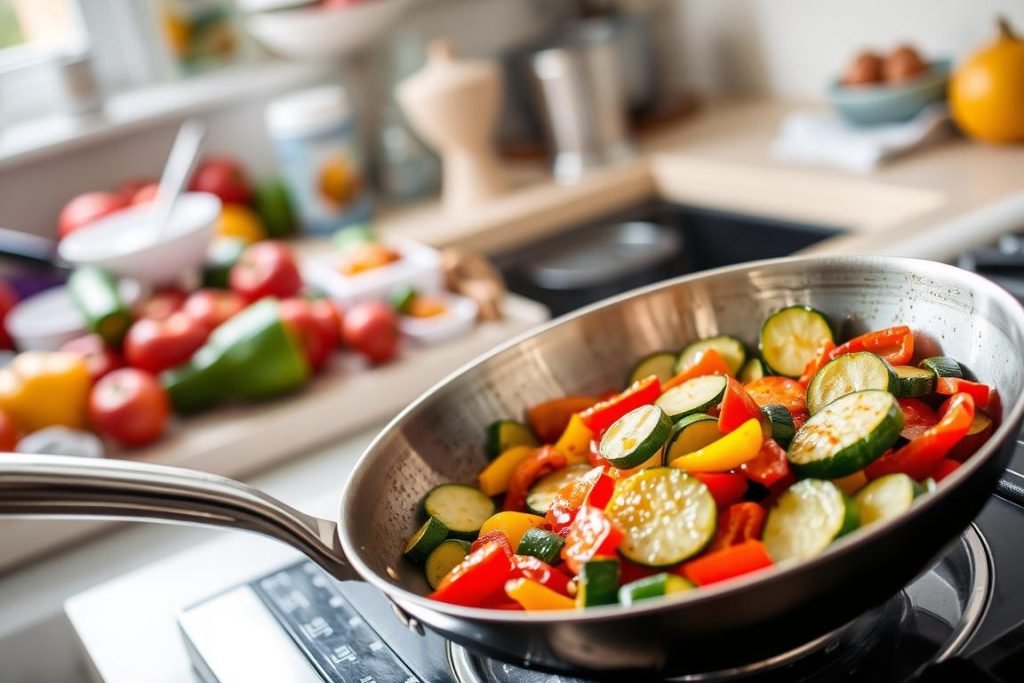
Getting these techniques right takes practice and patience. Just focus on proper techniques, avoid overcrowding, and use the right temperature. Doing so elevates your sautéed dishes, making them golden and flavorful. Mastering sautéing enhances your meals and your enjoyment of cooking.
Creative High Heat Sautéing Recipes
Step into the exciting world of high heat sautéing. Here, quick cooking meets flavor and nutrients. Learn to make dishes that are fast, tasty, and healthy.
Vegetable Stir-fry Ideas
Want a fast, healthy meal? Try vegetable stir-fry. Cooking veggies quickly over high heat keeps them crunchy and full of vitamins. It all happens in less than 20 minutes. Here’s how to do a great vegetable stir-fry:
- Heat Prep: Start by warming some olive oil in a big skillet on high heat.
- Hard Veggies First: Put in harder veggies like carrots and onions first. They need more time to cook.
- Add Soft Veggies: Add softer veggies like mushrooms and zucchini later. This keeps them from getting mushy.
- Season Well: Use basic seasonings like salt and pepper. A little butter adds extra flavor.
- Quick Toss: Stir your ingredients quickly. This prevents burning and cooks everything evenly.
This cooking style makes your dish full of fiber and nutrients. Plus, you can serve it with proteins or by itself as a filling meal.
Quick Proteins to Try
Sautéing proteins on high heat is quick and tasty. Foods like chicken, shrimp, or steak get a flavorful crust. This way, they cook in just a few minutes. Here’s the best way to cook proteins:
- Prep Protein: Use thinly sliced proteins for quick, even cooking.
- High Heat: Heat the oil until it shimmers, then add your proteins.
- Don’t Overcrowd: Cook in small amounts. This way, everything cooks properly.
- Season Simply: Salt and pepper usually do the trick. Or add spices like paprika for more flavor.
This method is perfect for those with busy lives. It’s also good for various diets, including keto and low-carb.
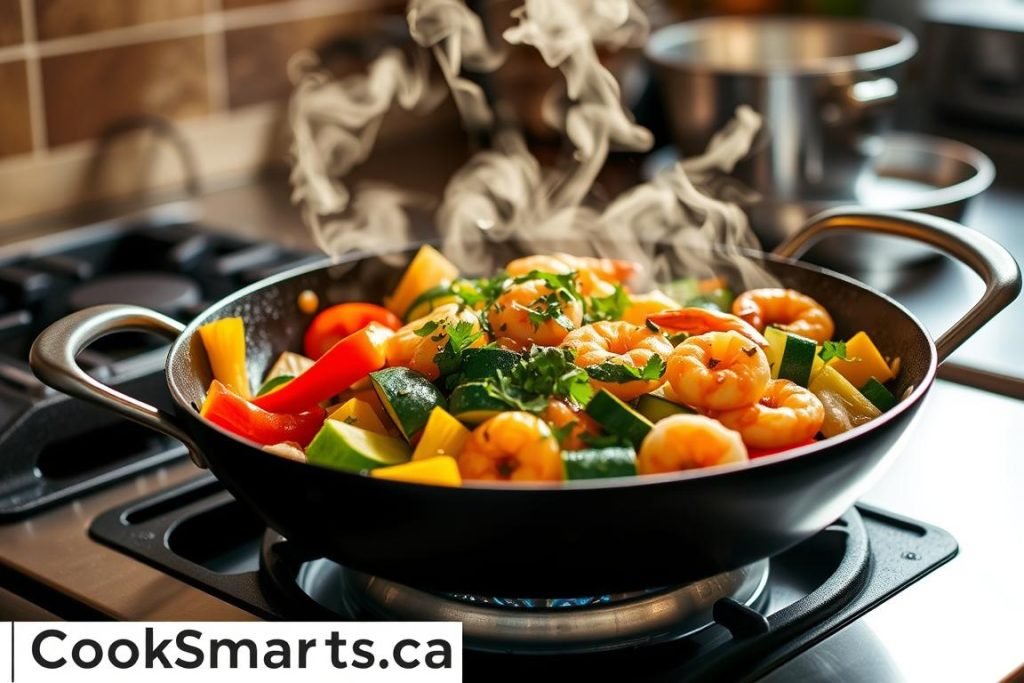
Trying a quick vegetable stir-fry or sautéing steak slices brings you closer to a tasty meal. Use these techniques to improve your cooking skills. They make mealtime easy and fun.
Cleaning and Maintaining Your Cookware
Mastering the art of high heat sautéing is one thing. Caring for your cookware properly is another. Different materials like nonstick and stainless steel need specific care. It’s important to keep your skillets in top shape. This improves your cooking experiences. Make sure to dry your stainless steel cookware immediately after washing. This prevents water spots and keeps it looking good for years.
Proper Care for Nonstick vs. Stainless Steel
Nonstick pans require gentle handling. It’s best to use non-abrasive cleaners and sponges for washing them. Don’t use cooking sprays. They can harm the nonstick surface over time. Stainless steel pans, however, can take tougher cleaning. Clean them regularly to avoid buildup. Food Network suggests heating the pan before adding oil. This step helps avoid food sticking and protects the pan’s surface. Following temperature guidelines is essential too. For example, All-Clad pans can withstand oven temperatures up to 600°F. But, don’t overheat stainless steel to avoid discoloring it.
Tips for Long-Lasting Skillets
Avoid thermal shock to prevent warping your cookware. Always let pans cool before washing them. This keeps them in shape. If there’s tough residue, soak the cookware in hot soapy water. Or use a mix of water, vinegar, and baking soda for a gentle clean. For cast iron care, like with STAUB Cocottes, stay away from harsh cleaning agents. Also, don’t preheat them empty. Regular maintenance keeps your cookware ready for cooking. It ensures your investment in high-quality pots and pans pays off with great meals.